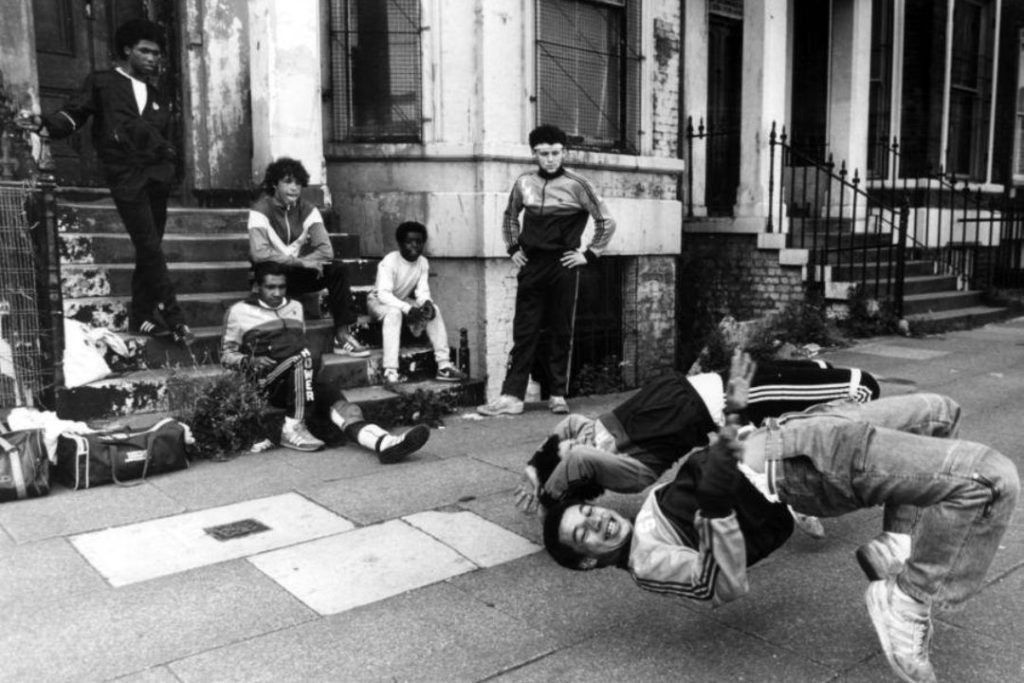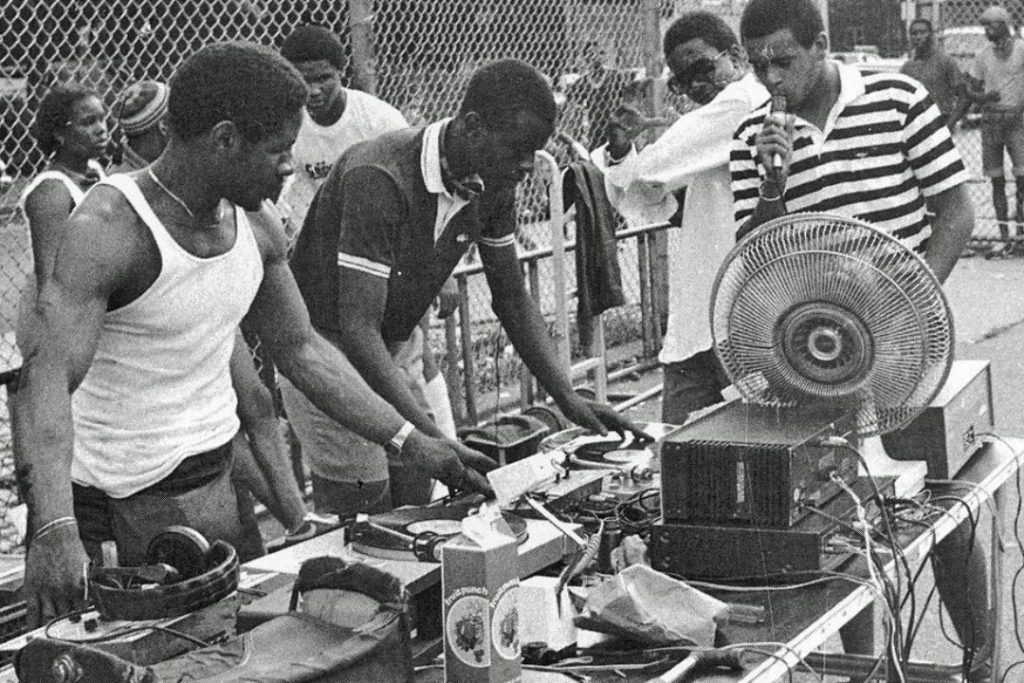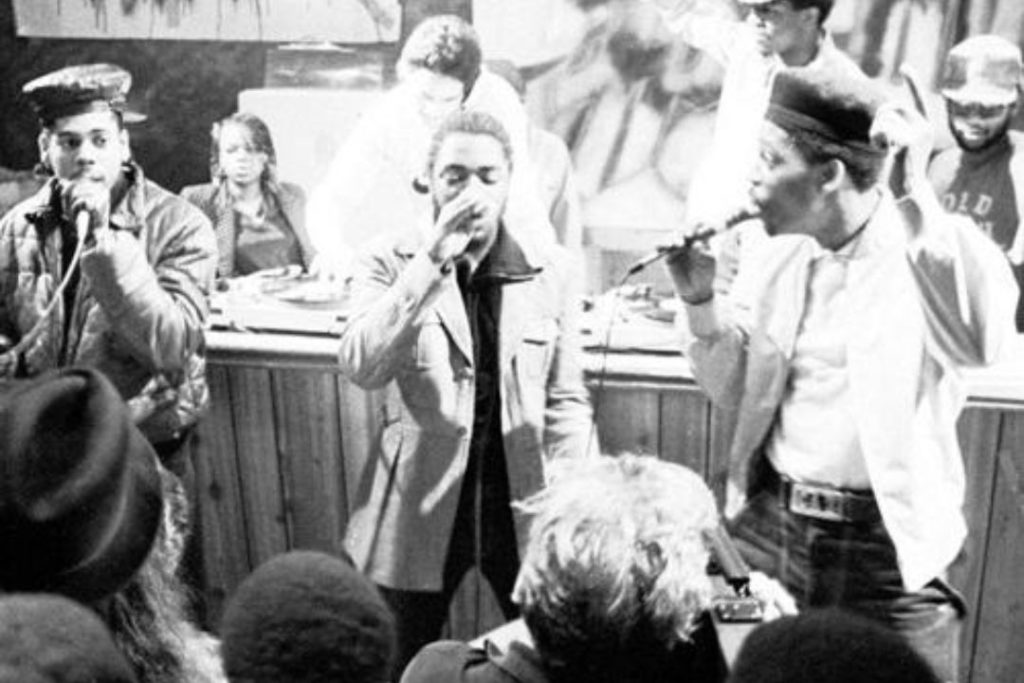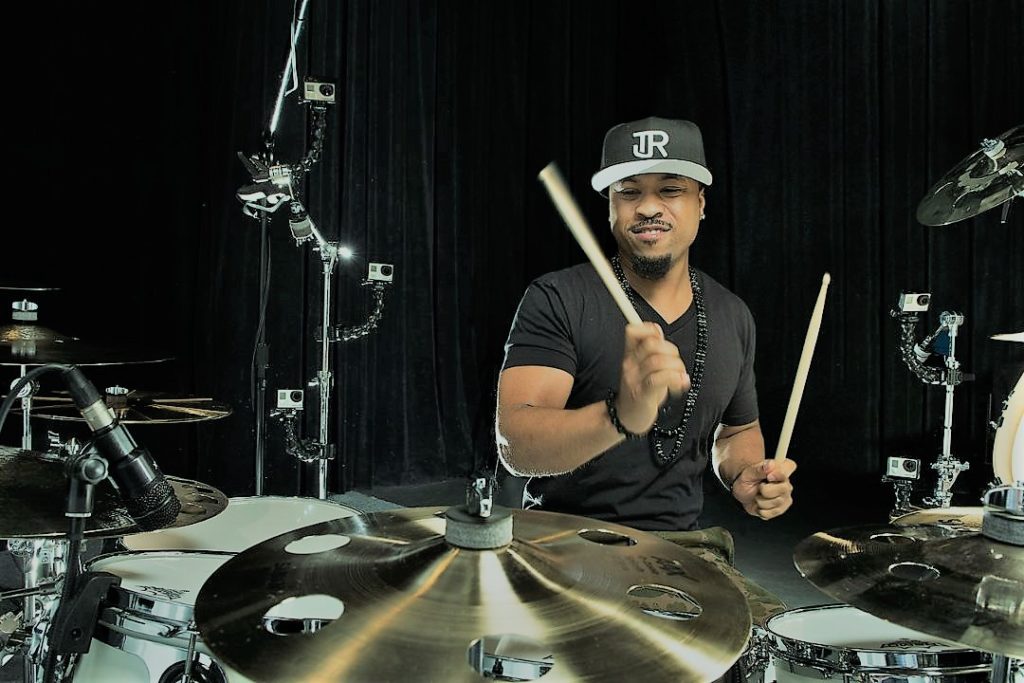Are you a drummer or a producer looking for Hip Hop drum patterns? If you’re looking for inspiration, you came to the right place.
In this article, I’ll list 10 Hip Hop drum patterns everyone should know. I’ll include drum notation and sound files so you can easily follow along.
But first, let’s talk about the history of Hip Hop and how it influenced drummers all over the world.
Hip Hop music, also known as Rap music, is part of the cultural movement that started in the Bronx, New York City, in the ‘70s.
That movement included things like rapping, DJing, breakdancing, and street art. For us drummers, the beat is the most important part.
They are usually made from electronic instruments or old samples, and using a DJ instead of musical instruments during live performances was common practice.
Nowadays, most rappers are backed by a live band and the beats are pretty simple so they won’t distract you from the central piece: the rapper.
They’re mostly rock beats, in the sense that the bass drum emphasizes downbeats, and occasionally, offbeats.
On the other hand, the snare usually lands on beats 2 and 4 in a 4/4 time signature and acts as the backbeat. Ghost notes are also common, to add feel and drive the music along.
Finally, the Hi-Hat or other high-frequency percussion is where things get interesting. It usually includes many different embellishments like open Hi-Hats to accentuate certain beats, Hi-Hat rolls, and much, much more.
If you’re new to the genre, this list of patterns is a solid foundation before you jump to more complex Hip Hop drum patterns.
Now that we know where it all started, let’s take a look at ten hip hop drum patterns everyone should know:



Hip Hop Drum Pattern #1
My first suggestion is something everyone learns in one of their first drum lessons. It’s based on the basic backbeat and it’s often heard in rock, pop, and hip hop playlists.
Assuming a 4/4 time signature, a backbeat type of groove usually means the snare drum lands on beats 2 and 4 of each measure.
On the other hand, you play the bass drum on beats 1 and 3. If you’re not familiar with how an 8th note beat works, the way you count one is “1, and, 2, and, 3, and, 4, and”.
Additionally, to add some flavor to the basic pattern, play another bass drum on the “and” after the “1”, and after the “3”.
To wrap the beat, play the Hi-Hat all the way through, eight times per measure, and you’ve got yourself a basic Hip Hop drum pattern.
Here’s what it looks like as drum notation:

And what it sounds like:
You can also hear this exact beat in the song:
Hip Hop Drum Pattern #2
The next drum pattern is straight out of one of the most iconic Hip Hop tracks, and also one of my favorite songs.
It’s not as easy as the first one, but nothing out of the ordinary either. Let’s start with the easiest part, the Hi-Hat.
In this drum pattern, you play the Hi-Hat as straight 8th notes. In other words, on each beat, and each “and”, eight times per measure.
On top of that, the bass drum pattern is also fairly simple, but this time it’s two measures long.
You play the bass on beat 1, and the “and” of beat 3 of every measure. On the second measure, you include an additional bass drum note on the “and” of beat 1.
The snare drum is the trickiest part, but nothing out of the ordinary either. Two of the three snare notes land on beats 2 and 4, as usual.
If you think about it as a 16th note groove, you count it like “1 e and ah, 2 e and ah, 3 e and ah, 4 e and ah”. In that case, the third snare lands on the “e” of the third beat.
Confused? Here’s what it looks like as drum notation:

And what it sounds like:
As I said in the beginning, you can hear this exact beat in the popular song
Hip Hop Drum Pattern #3
My third suggestion is another classic, and one of the funkiest Hip Hop drum patterns of all time.
We’ll look at it as a 32nd note groove. If you don’t know how to count 32nd notes, it’s identical to counting 16th notes, but instead of counting each note, you count every second note.
The Hi-Hat is the easiest part of the groove since you play it just like you do in any straight 8th note groove. That is eight times per measure, on every beat and the “and” of each beat.
On top of that, the snare drum pattern is just as easy. Play it on the “and” of every beat and you’re good to go.
The bass drum is the hardest part, so let’s go step by step. Firstly, you play the bass drum on every single beat.
In the first eight 32nd notes, you also play it between the 1 and the “e”, as well as on the “ah”.
You add another bass drum note between the “ah” of the third beat and the fourth beat, and that’s it.
It might be hard to grasp by just reading it, so here’s what it looks like as drum notation:

And what it sounds like:
You’ve probably heard this song before, but if not, here’s where it comes from:
Hip Hop Drum Pattern #4
The fourth drum pattern is pretty straightforward, especially when compared to the previous pattern.
It’s an 8th note groove and as we’ve seen before, you count it like “1, and, 2, and, 3, and, 4, and”.
The Hi-Hat and snare patterns are more of the same with a couple of things that stand out on the second measure.
In other words, you play the snare drum on beats 2 and 4, but instead of striking the snare in the center, you play cross stick.
On top of that, the Hi-Hat is played as 8th notes, or eight times per measure. The only difference is, every second measure, you play an open Hi-Hat on the “and” of the third beat.
The bass drum is played on beat 1, on the “and” of beat 2, on beat 3, and the “and” of beat 4.
Additionally, the same happens on the second measure, but you add another bass drum note on the “and” of beat 3, exactly where you play an open Hi-Hat.
With everything put together, here’s what it looks like as drum notation:

And what it sounds like:
If you’ve ever played GTA: San Andreas, there’s no way you don’t recognize this beat from listening to “Radio Los Santos” all day:
Hip Hop Drum Pattern #5
I couldn’t write a whole article about Hip Hop without mentioning The Notorious B.I.G., one of the greatest of all time.
This beat in particular is based on the basic backbeat, with a few additional strokes that make all the difference.
On that note, I like to look at this pattern as a 32nd note, and we count it the same way we did with pattern #3.
Once again, you play the Hi-Hat as straight 8th notes, landing on every beat, as well as on every “and”.
The snare drum couldn’t be easier, since you play it on every “and” and that’s it.
On the other hand, the bass drum pattern isn’t as easy for a beginner that was never exposed to something like this.
Either way, this is how you play the bass drum pattern: on the first beat, it lands on the beat, between the “and” and the “ah”, and on the “ah”.
On the second beat, there’s a single bass drum note that lands exactly on the beat, and the third beat is exactly like the first one.
The fourth and final beat is similar to the second one, but you add another note on the “e”
It might be hard to understand at first, so here’s what it looks like as drum notation:

And what it sounds like:
This exact beat was used multiple times over the years, but it’s best known as the beat from:
Hip Hop Drum Pattern #6
To mix things up, the next Hip Hop drum pattern is a 16th note one that feels and sounds faster than all the previous patterns.
Starting with the Hi-Hat, you play it four times per beat, which results in sixteen times per measure.
For additional flavor, on the “and” of the third, and the fourth beat you play an open Hi-Hat.
As far as the snare drum goes, nothing changes, since it lands on beats 2 and 4, as usual.
Additionally, the pattern includes five bass drum notes with the first two on beat 1, and on the “ah” of beat 1.
The next three notes are played on the “and” of beat 2, as well as on the “e”, and “and” of beat 3.
If you put everything together, this is what it looks like as drum notation:

And what it sounds like:
You can listen to this exact hip hop drum pattern in the masterpiece called:
Hip Hop Drum Pattern #7
The seventh drum pattern is one of the easiest, if not the easiest on the whole article.
For example, the Hi-Hat is more of the same. If we think about it as a 16th note groove, you play 8th notes on the Hi-Hat, on every beat, and every “and”.
Additionally, the same happens with the snare drum that, as usual, lands on every 2nd, and 4th beat.
As far as the bass drum goes, there’s a bass drum note of beat 1, and on the “ah” of that same beat.
Then, there’s another one on the “and” of beat 2, and another one on the “and” of beat 3.
To conclude, it’s safe to assume most drummers won’t have a problem learning and playing this basic beat, but as usual, here’s what it looks like as drum notation:

And what it sounds like:
You can hear and play along with this exact Hip Hop drum pattern on the worldwide famous tune:
Hip Hop Drum Pattern #8
This next pattern comes from a song I’m sure almost everyone heard at least once or twice in their lifetime.
The groove is pretty basic, but also fun to play, especially if you play along with that specific song.
Once again, we’ll look at it as a 16th note groove, and besides the whole third beat, it’s just another basic backbeat.
On that note, the Hi-Hat is played as a straight 8th note pattern, where you play the Hi-Hat every beat, as well as every “and”.
The snare drum pattern doesn’t change much either, since you play it on beats 2 and 4. The difference is, there’s an additional note on the “e” of the third beat.
To conclude the groove, there’s a bass drum note on the first beat and another one on the “ah” of the third beat.
Easy, right? It’s even easier when you look at the drum notation:

And what it sounds like:
In the end, you can have the time of your life rocking along with one of the most recognizable Hip Hop tracks in the world:
Hip Hop Drum Pattern #9
This next drum pattern is also fairly easy to learn, but feels good to play, despite the simplicity.
Starting with the snare drum, every single note lands on the second and fourth beat, which is more of the same.
The bass drum pattern is, as usual, played on the first and third beat of each measure, but there’s a small difference. On every second measure, there’s an additional bass drum note on the “and” of the second beat.
On top of that, the Hi-Hat pattern is half a measure long and repeats all the way through. It goes like this: on the first beat, you play it twice on the “and”, and on the “ah. On the second beat, there’s a single note that lands on the “and”.
After that, the pattern repeats over and over, making it one of the easiest Hip Hop drum patterns to learn.
If you’re still struggling with this specific pattern, here’s what it looks like as drum notation:

And what it sounds like:
If you want to have a good time, here’s where you can listen this exact drumbeat:
Hip Hop Drum Pattern #10
The tenth and final hip hop drum pattern is my favorite one from the list, straight from the track that made me fall in love with the genre.
It’s not easy to learn or to play, and therefore you must be an intermediate drummer to play it properly.
Firstly, the whole groove consists of a 16th note pattern that’s two measures long, with the second one being the hardest to learn.
Snare Drum
The snare drum pattern is the only easy part of the pattern, since, as usual, the snare lands on beats two and four, all the way through.
Hi-Hat
Now, let’s dissect the Hi-Hat drum pattern. On the first four 16th notes, the Hi-Hat is played on the beat, and the “and”. So far so good.
Additionally, on the second group of 16th notes, the Hi-Hat is played on the beat, the “and”, as well as on the “ah”.
The third group of 16th notes has two Hi-Hat notes on the “e” and the “and”, while the fourth group is a repeat of the second.
On top of that, the Hi-Hat pattern on the second measure is the same, except in the final group of 16th notes that includes a single open Hi-Hat on the “and”.
Bass Drum
With the Hi-Hat and snare drum pattern out of the way, let’s analyze the bass drum pattern instead.
On the first measure, there’s nothing new to learn, since it lands on the first and third beat, which is something we are used to.
On the other hand, on the second measure, it lands on the first and third beat, but it doesn’t stop here. There’s also a bass drum note on the “and”, as well as the “ah” of the third group of 16th notes.
To conclude the pattern, there’s also an additional bass drum note on the “e” of the fourth group of 16th notes.
If you’re a visual learner like me, reading the beat as drum notation makes it much easier to learn and absorb:

And what it sounds like:
Curious about the track I was talking about in the beginning? Here’s the masterpiece:
Final Words
Hip hop is one of my favorite music genres in the world. It’s always a fun time to lock in a groove along with one of the many iconic Hip Hop tracks.
If you’re looking to dive deep into this specific music genre, I advise anyone to learn every single drum pattern in the article.
There’s everything from the most basic drum pattern, to ones that require at least an intermediate level of knowledge, so start with the ones that make sense to you.
Anyway, if you’re in the mood, HERE’s a playlist that features some of the most iconic old-school Hip Hop tracks.
All in all, I hope this article achieved its main purpose of briefly educating you on the history of Hip Hop, and which are the Hip Hop drum patterns everyone should know.

